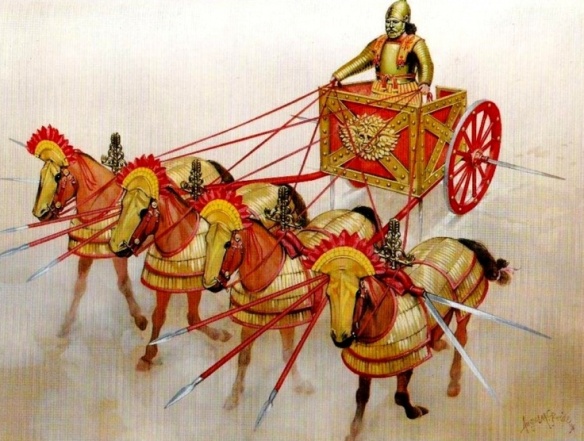The death of Alexander the Great brought a struggle among his subordinates for succession to his throne. As many as 11 of his commanders vied for position, but it finally became a struggle among three: Antigonus controlled Macedon, Seleucus took over most of what had been the Persian Empire, and Ptolemy became ruler of Egypt. Not satisfied with their holdings, the three fought among themselves for more land; often, two of them allied against the third in an ever-changing set of partnerships. Seleucus controlled the largest of the three domains, but his successors had the most difficult time in maintaining it. Seleucus established his capital at Babylon in 312 B.C.E., but spent most of the rest of his life suppressing revolts by provincial governors. Syria was a continual source of trouble. His victory at the battle of Ipsus in 301 B.C.E. gave him control of the important trade center, but keeping it was another matter.
Upon Seleucus’s death, his son Antiochus I inherited the throne and had to fight on all frontiers. He was the first to war with Egypt over Syria, losing it to Ptolemy II in the First Syrian War of 280–279 B.C.E. Antiochus allied himself with Antigonus after the Macedonian had to suppress several Greek rebellions subsidized by Ptolemy. Antiochus invaded Syria in 260 B.C.E., and Antigonus engaged and defeated the Egyptian fleet off the island of Cos in 258. Ptolemy sued for peace in 255. Ptolemy III regained Syria in a Third Syrian War, 246–241 B.C.E., while Seleucus II was busy fighting a civil war against his brother. Seleucus was aided in this by the city-state of Pergamum on the Turkish Adriatic coast, which had a brief career as arbiter of Asia Minor politics.
The Seleucid Empire reached the height of its power under Antiochus III, called “the Great.” He regained territory in Asia Minor from Pergamum; he fought yet another Syrian war to little effect; he suppressed a rebellion in Asia Minor (216–213); he defeated Armenia and forced them to recognize his suzerainty; and he invaded Parthia, the power that had succeeded the Persians in the east. At the battle of the Arius in 209, he forced the Parthian king Araces III to become his vassal. Moving farther east, Antiochus III fought the Bactrians (in modern day Afghanistan) and forced their submission, after which he marched down the banks of the Kabul River into northwestern India. In 205–204, he campaigned down the Persian Gulf to conquer Gerrha (modern Bahrain). His final successful effort was another war in Syria, in which he took advantage of the infant king Ptolemy V. Again allying his nation with Macedon, now under Philip V, Antiochus easily defeated Egyptian forces in the key battle at Panium in 198, which gave him control over Palestine, Syria, and Asia Minor. Macedon was of little assistance because it lost battles to Pergamum and Rome.
The rising power of Rome spelled the end of Seleucid power. After defeating Philip V, the Romans continued onward toward Syria. The Romans and Seleucids fought their major battle at Magnesia in December 190 B.C.E. After achieving the upper hand early on, Antiochus’s forces were broken when their elephants suddenly became uncontrollable and trampled their own army. The Romans took the victory, but did not take territory for themselves. Instead, they gave Asia Minor and Antiochus’s Greek possessions to Pergamum and Rhodes at the Peace of Apemeax in 188 B.C.E. This defeat and Antiochus’s death the following year brought about a general revolt throughout the Seleucid domain.
Antiochus IV managed to hold on to power for a while, even defeating Egypt twice, but he was forced by Rome to evacuate. His occupation of Palestine after that evacuation was so harsh that it provoked a Jewish revolt: the war of the Maccabees. He restored Seleucid dominance in the east, but a succession struggle broke up the empire. More revolts and the rising power of Parthia under Mithradates served to bring the Seleucid dynasty to an end late in the second century B.C.E.
Despite the fact that the Seleucids spent almost their entire tenure in wars, there were some positive results of their time in power, mostly in the implementation of Alexander’s legacy of Hellenism throughout the Middle East. Greek settlers and retired veterans established Greek communities throughout the area, making Greek the language of science and the arts. Greek schools kept alive the sciences and philosophies of Greece and served to introduce Stoicism to the region, an outlook that had effects on the establishment of Christian doctrine. Without strict religious oversight or strong political order, the citizens of the empire were able to explore the ideas of both Eastern and European cultures and blend them into views unique to the area. Especially in religion, these views would arise as rivals to the gods of Rome and heresies to Orthodox and Roman Christianity.
